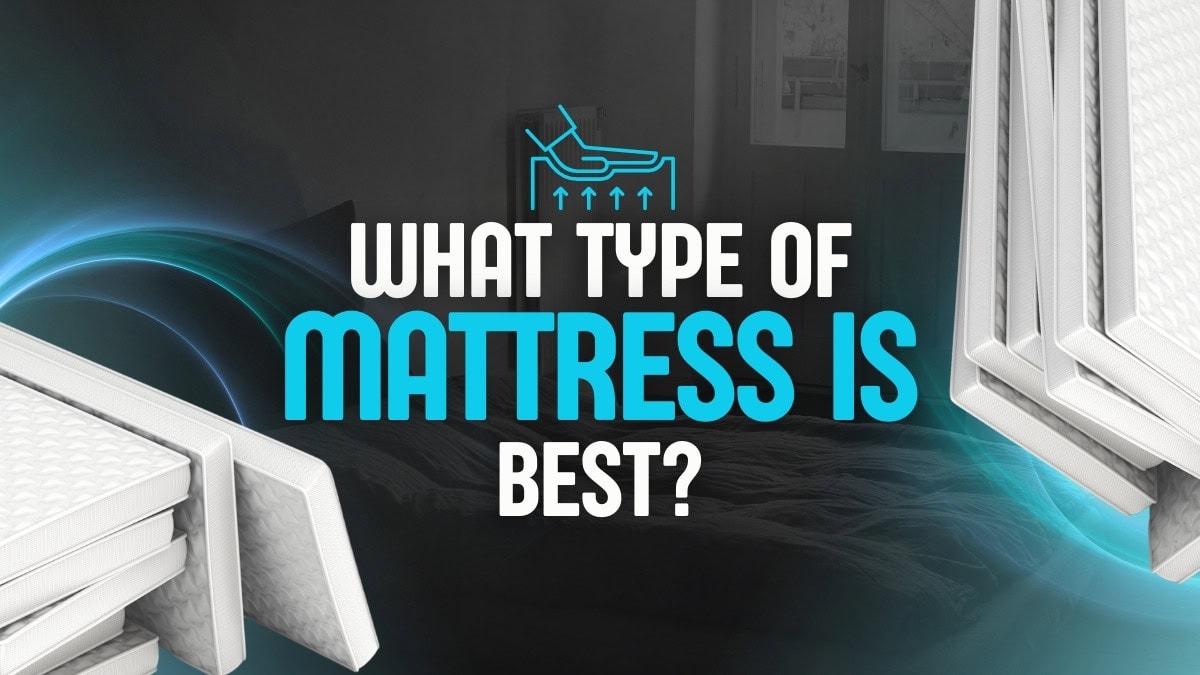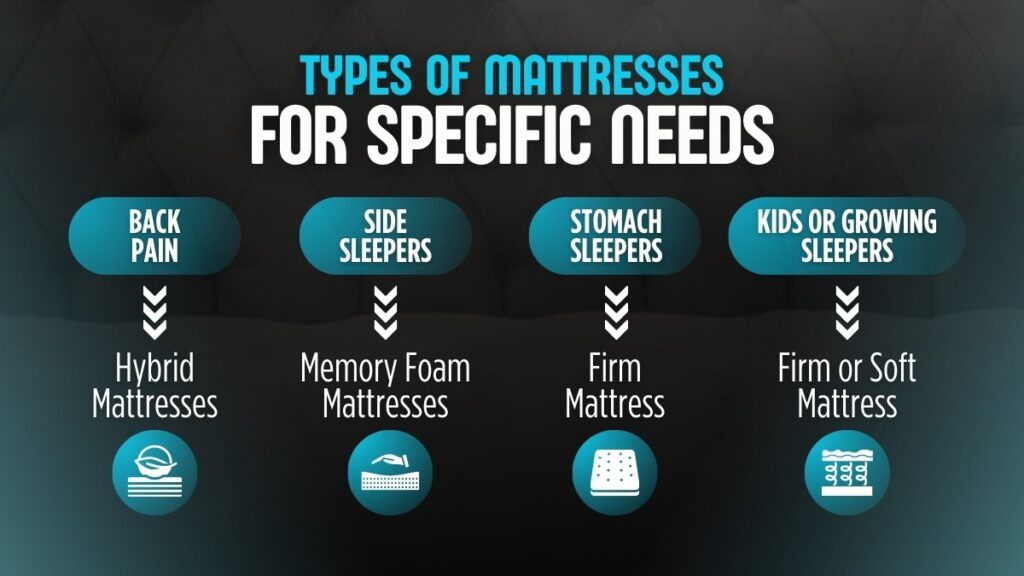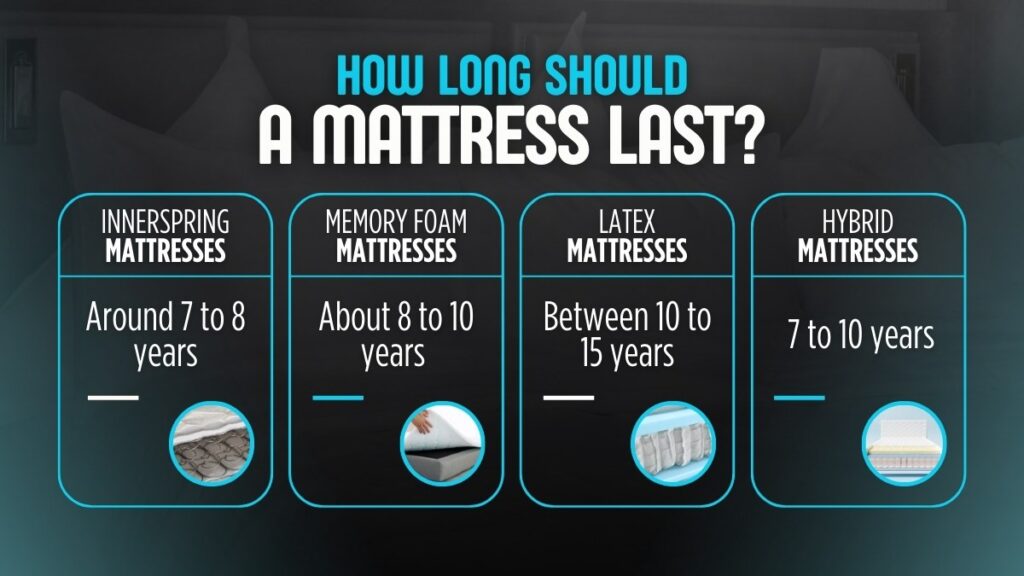
There’s no denying that different sleepers enjoy different types of mattresses, which makes choosing the ideal one a matter of choice. This article explores the various types of sleepers as we aim to determine what type of mattress is best for their needs, but let’s start with the basics!
Different Types of Mattresses
Let’s go through a brief overview of important mattress types as the first step toward choosing a good match for you.
Innerspring Mattresses
Innerspring mattresses are considered traditional and the most widely used. They have metal coils or springs to provide support, usually with a thin comfort layer on top. Some have interconnected coils, while others have pocketed springs, but most focus on durability and firmness.
On the surface, they could be viable if you’re looking for robust support and want a firmer feel. However, they lack the comfort you’ll find in foam mattresses, primarily due to motion transfer with their interconnected structure.
Memory Foam Mattresses
Memory foam mattresses “respond” to pressure and conform to your body, showcasing a contouring effect and pressure relief. They are a contrast to the innerspring type in that they offer motion isolation.
Traditional memory foam also retains heat, which can be a big deal for hot sleepers. Modern memory foam mattresses address this with cooling technologies to offer more breathability.
Latex Mattresses
Latex mattresses provide a responsive and resilient sleep surface. They are known for durability and the balance of support and comfort they feature. When you sleep on latex, it has a somewhat bouncier feel than memory foam.
As one of the best cooling mattresses, it offers better air circulation and is hypoallergenic. However, it’s also heavier and considerably more expensive.
Hybrid Mattresses
What is a hybrid mattress? Hybrid mattresses combine innerspring and memory foam to provide a balance between the two. They typically feature a core of pocketed coils and layers of memory foam or latex. These mattresses aim to grant both a supportive feel and contouring comfort.
On the flip side, this often comes at a premium price… and it could even go higher with more advanced features and complex constructions.
What Type of Mattress Is Best for Specific Needs?
Let’s discuss how your needs will affect your choice of mattress. Here’s how you can align your mattress purchase with your goals to enhance your sleep quality and overall well-being.

What Type of Mattress Is Best for Back Pain?
If you’re looking for back pain relief, you must pay attention to find that balance of support and pressure relief. Many sleep experts recommend medium-firm mattresses as the best mattress for back pain and sleep quality [1].
For example, hybrid mattresses could be an excellent choice. They combine supportive coils with contouring foam layers, which merge support and pressure relief in harmony.
What Type of Mattress Is Best for Side Sleepers?
Side sleepers place a lot of pressure on their hips as well as shoulders, so you’ll need ample cushioning to prevent discomfort and hopefully sleep better at night. Memory foam mattresses could be handy for most side sleepers due to the contouring we’ve talked about above, as well as the softness and support.
What Is the Right Mattress for Stomach Sleepers?
Stomach sleepers get a pretty similar response as those asking what type of mattress is best for lower back pain. A firm mattress offers comfort while preventing you from sinking. It’s a good choice thanks to its multiple foam layers and individually wrapped coils that support the lumbar region.
What Type of Mattress Is Best for Kids and Growing Sleepers?
When your body is rapidly developing, you may require supportive and adaptable sleep surfaces. Parents should pick mattresses that provide a balance of comfort and support. Firmer surfaces usually suit younger children, while softer options are more ideal as they grow up.
Types of Mattress Fillings and Their Benefits
The materials used in making mattresses make all the difference when it comes to comfort, support, durability, and performance. Let’s check out different mattress fillings and what they offer.
Foam Fillings
Foam fillings are a popular choice in modern mattresses, thanks to their range of options. The most common types include:
- Memory Foam: Known for its contouring effects, memory foam molds to your body, providing pressure relief and support. This particularly suits people with joint pain or pressure point issues.
- Gel-Infused Foam: Traditional memory foam can retain heat, yet gel foam addresses this by increasing airflow. This usually means a cooler sleeping experience, so it could be a go-to option if you want support but need relief from the heat.
Coil Systems
Coil systems have been a staple in mattress construction for decades, providing support through metal springs in various configurations:
- Open Coil (Bonnell Coil): Interconnected or continuous coils feature a firm and supportive feel and durability but also transfer motion more easily.
- Pocket Springs: Each coil is individually wrapped in its fabric pocket, allowing it to move independently and reduce motion transfer. It also provides more targeted support by adapting more precisely to your body’s contours.
Natural Materials
Natural mattress fillings have gained popularity with sustainability and health benefits in mind. Common ones now include:
- Latex: Natural latex is resilient and serves as a buoyant and supportive sleep surface. As already mentioned, it’s hypoallergenic and resistant to dust mites, with good airflow and solid temperature regulation.
- Wool: Known for even better temperature regulation, wool keeps you warm in the winter and cool in the summer. It wicks away moisture, so it can also mean a dry and comfortable surface for hot sleepers.
- Cotton: Soft and breathable, cotton also adds a plush feel to mattresses.
Mattress Longevity and Durability
Longevity and durability largely affect the type of mattress you need. Smart buyers (not just frugal ones) will always try to determine how long they can keep a product in great shape.
How Long Should a Mattress Last?

On average, mattresses last eight to ten years. After that, it’s time to recycle your mattress. However, this can vary based on the type of mattress and the materials used:
- Innerspring Mattresses: These typically last around seven to eight years, depending on the quality of the coils and comfort layers.
- Memory Foam Mattresses: Generally, they have a lifespan of about eight to ten years, with higher-density foams tending to be more durable.
- Latex Mattresses: Natural latex mattresses can last between ten to fifteen years.
- Hybrid Mattresses: Combining coils and foam, hybrids generally have a lifespan of seven to ten years.
How to Extend the Life of Your Mattress
Proper maintenance can extend the duration of your mattress’s life. Check out some tips to help you get the most out of your investment before you finally replace a mattress:
- Use a Mattress Protector Regularly: To protect your mattress from allergens and stains, cover it with a decent protector.
- Regular Cleaning: Vacuum your mattress periodically to remove dust and debris. Follow the manufacturer’s guidelines as well.
- Rotate the Mattress: Rotating your mattress 180 degrees every three to six months encourages even wear over time.
- Proper Support: Make sure your mattress has a sturdy foundation or bed frame to support its weight.
- Avoid Jumping onto the Mattress: Too much pressure from jumping or standing on the mattress can damage the internal parts.
Warranty and Return Policies
Warranty and return policies are crucial considerations when buying mattresses. They grant protection but also grant insight into the manufacturer’s confidence in its product. Most mattresses come with a warranty of about five years, typically covering defects in materials and workmanship.
Warranties will usually not cover normal wear and tear or damage resulting from improper use.
Remember that many manufacturers offer a trial period, allowing you to test the mattress in your home for anywhere between 90 and 365 nights.
Key Considerations When Choosing the Best Mattress
If you’re a first-time buyer, here are a couple of things you must bear in mind when picking a mattress for yourself.
Firmness Levels
Aside from the size of your mattress, the firmness will be the cornerstone of your decision-making process, as it will affect the alignment of your spine and address your needs differently [2]. Firmness is often categorized as soft, medium, or firm:
- Soft Mattresses: Great for many side sleepers, they provide cushioning for your hips and shoulders, aiding in pressure relief.
- Medium-Firm Mattresses: Suitable for back sleepers and combination sleepers, these showcase a balance between support and comfort.
- Firm Mattresses: Best for stomach sleepers, they provide greater support to maintain spinal alignment.
Temperature Regulation
Temperature regulation is most obviously vital for hot sleepers, but all buyers should keep in mind that:
- Traditional memory foam can retain heat without open-cell structures and gel infusions, which were developed to enhance breathability and cooling.
- Latex is naturally breathable, so it encourages better airflow and helps maintain its coolness.
- The coil systems in innerspring and hybrid mattresses promote airflow and help manage the temperature.
- Breathable materials play a big role in overall quality and temperature control.
Motion Transfer and Edge Support
If you’re not sleeping alone, motion transfer and edge support will be just as important when buying a mattress. Motion transfer refers to the movement you’ll feel across the mattress surface when your partner shifts or moves. As for edge support, this can determine the stability and support at the mattress’s perimeter.
A foam mattress and a latex mattress typically excel in isolating motion, while innerspring and hybrid mattresses often feature reinforced edges to ensure proper support.
Price vs. Value
Assess the value any brand offers against the cost of the mattress to find the best value for money. Regardless of your budget, you should look for companies featuring:
- Material Quality: High-quality materials usually mean enhanced durability and comfort.
- Warranty and Trial Periods: Extended trial periods and long warranties can grant you peace of mind when buying a mattress.
Why are mattresses so expensive? A more expensive, durable mattress may equate to better value over time because you probably don’t want to spend additional money on frequent replacements. Remember to balance cost with the quality and features you need.
Mattress Shopping Tips
Let’s streamline your buying process and try to make this investment as straightforward as possible.
Set a Budget
Whether you’re shopping for a luxury mattress or a more affordable one, your budget will play a major role and determine how far you can reach with both quality and features, so you’ll need to:
- Assess Your Financial Limits: Determine an amount you can spend and make sure that it aligns with your financial situation but also allows for a quality purchase.
- Research Price Ranges: Discover the typical costs of different mattress types and brands first, and only then should you set your expectations.
- Consider Financing Options: If you find it challenging to balance your budget and your needs, you can check out retailers offering financing plans and go from there.
Understand Mattress Certifications and Standards
If you’re looking for assurances on safety, quality, or environmental impact, check out certifications and learn more about the mattress standards:
- CertiPUR-US ensures that the foam used in mattresses is made without harmful chemicals and meets performance standards.
- OEKO-TEX Standard 100 certifies that textiles are free of harmful substances.
- The Global Organic Textile Standard (GOTS) confirms that the materials used in any product are organic, eco-friendly, and produced sustainably.
Find a Brand You Trust
Brand reputation often indicates product quality and customer service, and this is what it all comes down to. To find your (new) favorite brand, take a closer look at:
- Customer Reviews: Analyze feedback and consensus online, focusing on customers with similar needs as yours to gauge how satisfied they are.
- Transparency: Check out your preferred brand’s materials, manufacturing processes, and policies. Go for companies that prioritize customer trust and transparency on most fronts.
- Customer Support: Established brands typically have rock-solid customer support services, which suggests better reliability. Look for proven track records and ease of communication with representatives from the start.
Buying Online vs. In-Store
Online and in-store buying are two different things, and we’ll discuss what each one involves below.
Online Shopping
Online shopping is all about convenience and access to a range of options. This means competitive pricing for both premium and affordable mattresses and often even more generous trial periods, as you can easily compare different brands and vendors.
On the other hand, you won’t be able to try out the mattresses in person before purchasing them. Thankfully, most online sellers grant you trial periods that give you the chance to see if the mattress suits you.
In-Store Shopping
Shopping at physical locations allows you to test mattresses and feel them before making a purchase.
Plus, it also means a more personal approach where you can talk to sales reps. Don’t know what type of mattress is best for an adjustable bed or your kid’s newly assembled room? Hoping to find the best mattress topper? The in-store staff is bound to send you in the right direction in minutes.
On the flip side, you’ll be limited to the stock that’s available at the time. Moreover, it’s usually more expensive to buy mattresses from a physical store than online due to the lesser room for comparative buying.
Expert Insights
What type of mattress is best, according to experts? Factors such as body weight, sleeping position, and personal comfort preferences play a crucial role in choosing the best mattress.
According to the Sleep Foundation, an expert organization on sleep health education, side sleepers typically benefit from a softer mattress that cushions pressure points, while back and stomach sleepers require a medium-firm surface to maintain spinal alignment [3] [4].
Experts also emphasize the importance of motion isolation in foam mattresses, which is particularly beneficial for couples who share a bed [4].
Additionally, materials and cooling features are essential considerations. In his sentiments on The Sleep Doctor platform, Dr. Michael Breus, a clinical psychologist and board-certified sleep specialist, suggests that hot sleepers should look for breathable materials like latex or hybrid designs with cooling gels to prevent overheating at night [5].
Latex mattresses are naturally more breathable and durable, making them a great option for those seeking longevity and temperature regulation [5]. Ultimately, the best mattress is the one that aligns with an individual’s sleep habits, health needs, and comfort preferences.
 11 Niche Experts
11 Niche Experts
 100+ Product Reviews
100+ Product Reviews
 50+ Tested Products
50+ Tested Products
At BestDaily, our mission is simple: to help you make confident, informed decisions about the products that impact your daily life. Whether you're searching for wellness essentials or lifestyle upgrades, we combine hands-on testing with expert analysis to highlight what truly works.
FAQs
Got more questions about the different types of mattresses? Below, we’ll talk about some of the commonly asked questions on mattress types and buying decisions.What Type of Mattress Is Best for Me?
What is the best type of mattress for you? This will depend on your preferred sleeping position, body type, and weight, and any specific concerns you may have. For example, if you are a side sleeper, you’ll likely enjoy a softer mattress, while back sleepers may need medium-firm mattresses instead. Test different mattress types to find one that offers the most comfort and support for the money.
How Often Should You Replace Your Mattress?
It will depend on the quality, materials, and usage of the mattress, but a rough estimate would be around seven years [6]. Noticeable sagging, great discomfort, or waking up with aches are all signs that it may be time to say goodbye to your old mattress and shop for a new one.
Is It Better to Sleep on a Hard or Soft Mattress?
The choice between a hard (or firm) or soft mattress depends on your sleeping position and other needs. Firm mattresses provide more support, while softer mattresses offer more cushioning, reducing pressure on the hips, shoulders, and other body parts. Always choose a mattress that balances comfort with adequate support for your preferred sleeping position.
Which Mattress Is Best, Spring or Foam?
As discussed above, both spring and foam mattresses have their advantages. Innerspring mattresses are known for their support and breathability, while foam mattresses excel in contouring the body and providing pressure relief. Lastly, hybrid mattresses combine elements of both to balance support and comfort.
What Is a Hybrid Mattress?
A hybrid mattress combines a coil-based support core with layers of foam on top of it, such as latex and memory foam. This design showcases responsive support and airflow of innerspring systems alongside the pressure relief and contouring benefits of foam layers. Hybrid mattresses are suitable for a wider range of sleepers but are also often more expensive.
Final Thoughts on What Type of Mattress Is Best
Selecting a fitting mattress can help boost the quality of your sleep and health, so it’s important to align the mattress type you pick with your actual needs.
At the end of the day, what type of mattress is best for you may not be the best for the next person. We’ve covered crucial factors you need to consider, but it’s up to you to choose the right mattress for yourself.
If you need more help finding one that ticks all the boxes, we suggest checking out individual mattress reviews. Happy mattress shopping!

